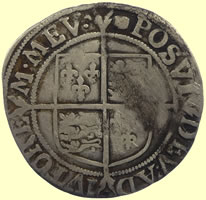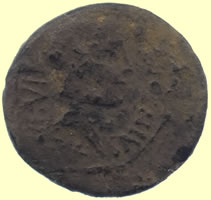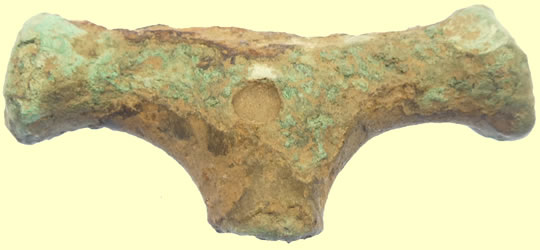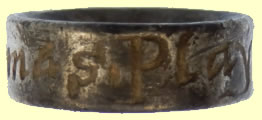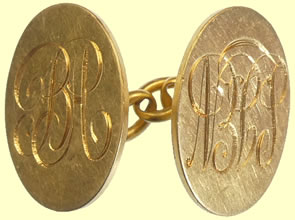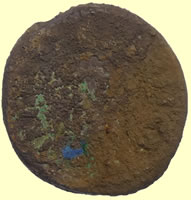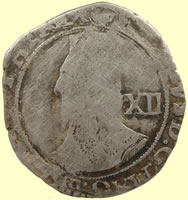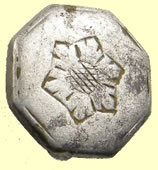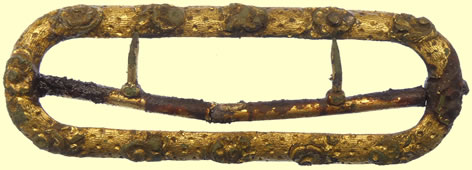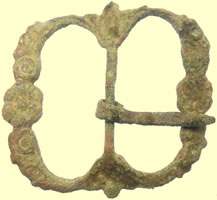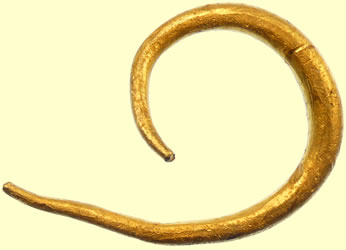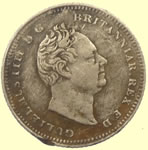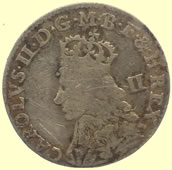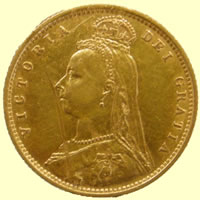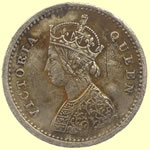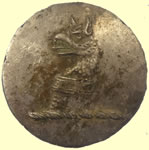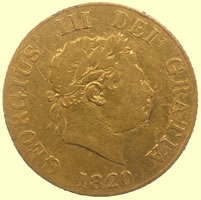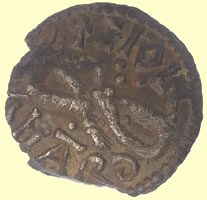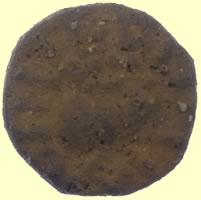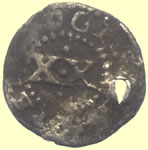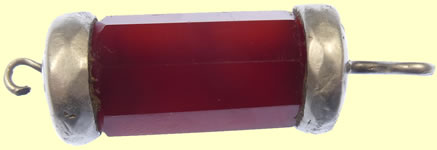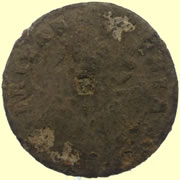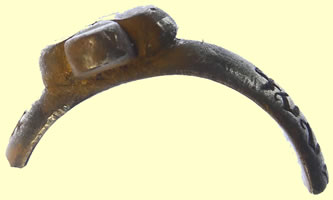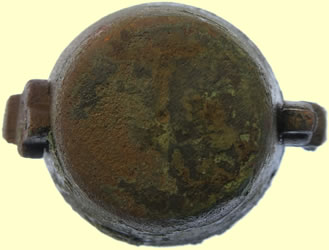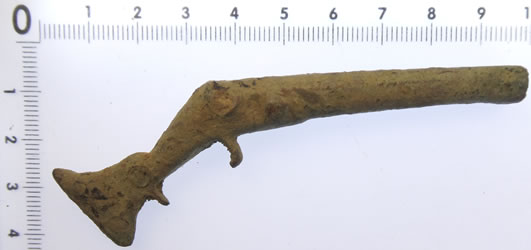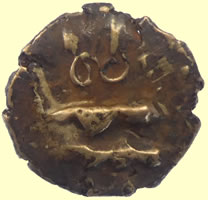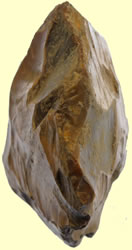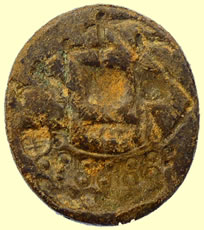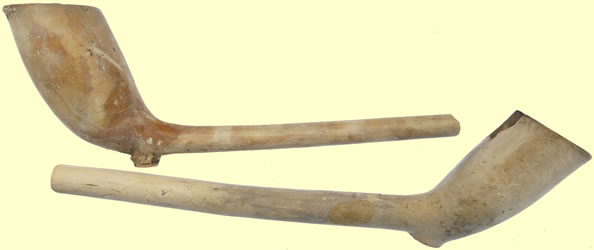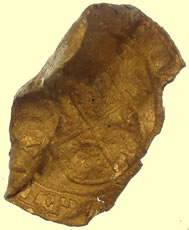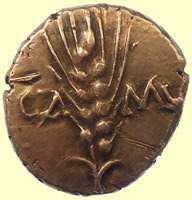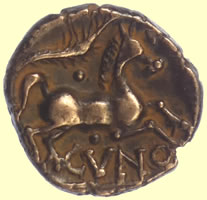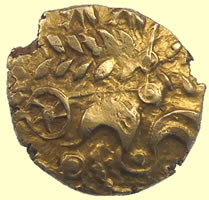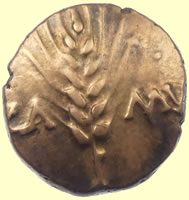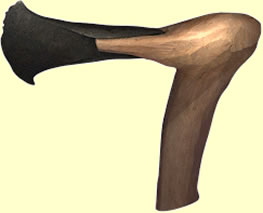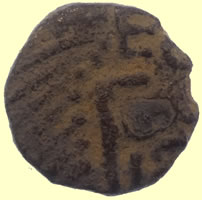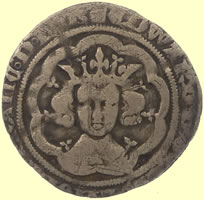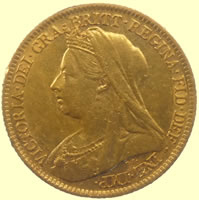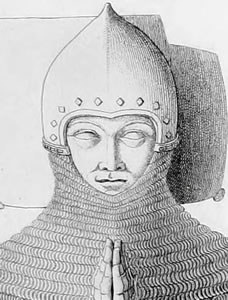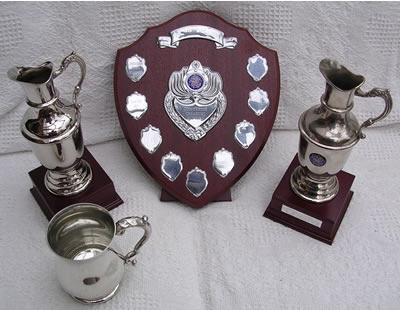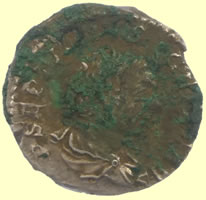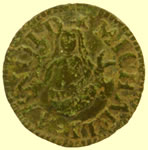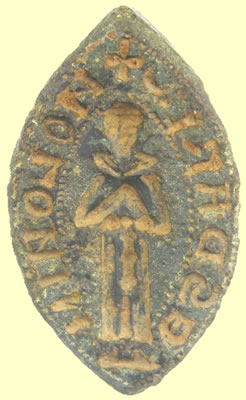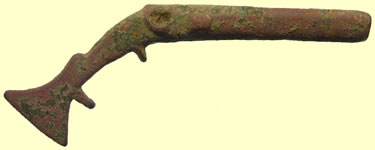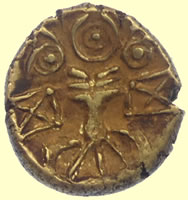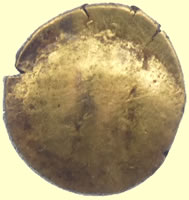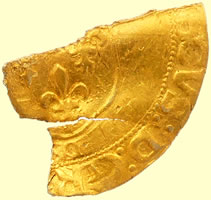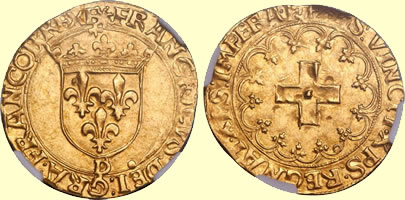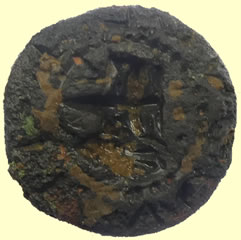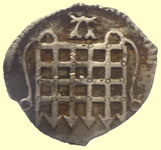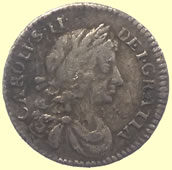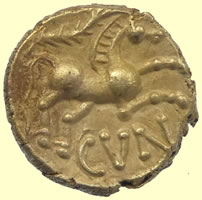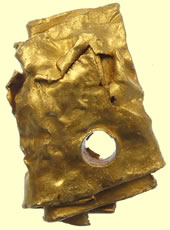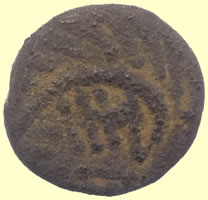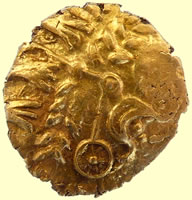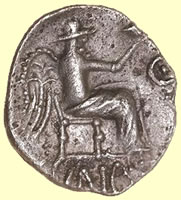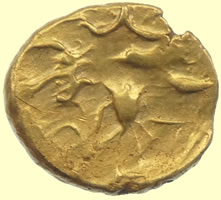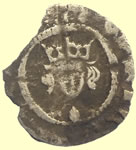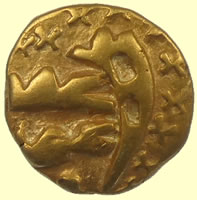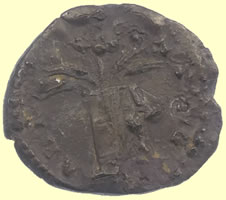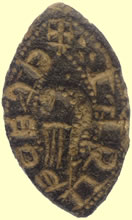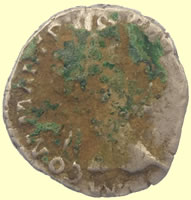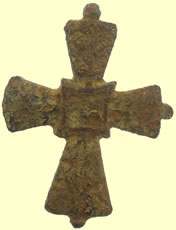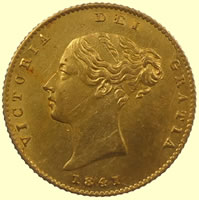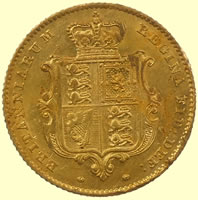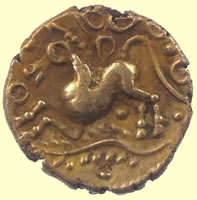

Metal detecting holidays in England with the World's most successful metal detecting club.
Twinned with Midwest Historical Research Society USA

Comments and ID's against Roman coins are from our expert Mark Lehman who also lectures on the subject in the USA
Comments and ID's against Celtic coins are from John Sills who runs the National Celtic Coin Index
Comments and ID's against early Medieval coins are from Dr Martin Allen who runs the National database at the Fitzwilliam museum
Comments and ID's on military buttons are from Tim Burton info@hamwichouse.com
Contact Louisiana Sal stateside for an American's view on hunting here sal@historyhunts.com
Contact Ark Gary for an American's view on hunting here goldeneggman@gmail.com
April 2018 to March 2020 archived news page17th March 2020 More Celtic gold and great silvers - Covid ends the huntsSince the outbreak of the virus I have been keeping a very safe distance from the guys and only processing finds at the end of each week. Lots of guys have cancelled their trips due to flight restrictions so the season will end early this year. I have loads of great finds to photograph and post yet that were found over the last couple of weeks.
The guys have been searching some of our huge new land with very mixed results. Lidar maps of the area showed at least half a dozen burial mounds scattered over the site. The area around the triple burial mound impressions above has only produced a couple of Roman 'grots' so far, it is a monster sized field and will take years to hotspot properly. However some of the other fields near very early houses have given up some really big hammered silver from medieval to Charles 1st and a beautiful silver ring inscribed 'JH 1521' in keeping with the house date of Henry VIII. Missouri Guy also found a very rare find for Essex, the earliest Bronze Age 2000 BC flat axe. It has twice the blade width of other example we have found over the years. Guy also found our first ever Scottish full medieval groat, all other coins have been pennies or half pennies. Check our Scottish hammered silver finds page Wiss Steve then popped the sweet 70 BC Morini Celtic gold qtr below, his 2nd target on the field !! I uploaded a load more new finds the 2020 Feb finds page. I have updated this years gold page with all the new gold finds Gold page.
2000 BC Early Bronze Age flat axe
Interesting silver ring with what looks like a rock crystal - 3.66g, 31mm long Inscribed 'JH 1521 The ring is inscribed from Henry VIII period - reported as treasure to museum.
70BC Morini Celtic gold qtr stater - sent to museum for recording 11mm,1.48g
First ever Scottish groat we have found 1329-71 David II hammered silver groat Obv DAVID DEI GRA REX SCOTORUM Rev VILL/AED/INBV/RGH- Edinburgh mint
1820 George IV milled silver half crown (30 pence)
600AD Saxon silver sceat - sent to EMC for ID and recording 1.13g, 11mm
First ever Romano/British double looped bronze protected terret I have seen ?
1904 Birmingham mint - Rose gold brooch
Crusty 50 BC Roman silver with unusual obverse - sent for ID
This is the closest I’ve been able to come. I truly wish I could discern more detail on the reverse, but this “match” seems plausible at least. The obverse is very close to a match, to the extent it can be seen. Gens: Sicinia, ca. 49/48 BC Q. Sicinius & C. Coponius
Would I bet my next social security check on this? – maybe not - but I think I got it pretty close seeing that we only had the obverse to go on, really, and much of that unclear as well. All the legible letters correspond to the legends on a clear specimen – the reverse is somewhat different, but these were all hand cut dies and so variety is the norm, within limits. I also suspect the reverse is double-struck about 25% to left on 2nd strike. You can see dotted border at 3:00-4:00 reverse, and I’m pretty sure the crescent you see inboard of that border from 5:00-6:00 is also a segment of border from a 2nd strike. The obverse is also just about exactly 25% off center to left Mark
|
||||||||||||||||||||
29th Feb 2020 Roman gold found - Oki Jim's vervel acquiredGa Buddy's Barn team head home after having a brilliant week searching and finding 7 more gold items. I have updated this years gold page with all the new gold finds Gold page. I have a few days break and the next team comes in on the 4th March, just time to catch up on photographing and uploading more finds. I uploaded a load more new finds including Roman silver to the 2020 Feb finds page. Mo Mike found only our 2nd ever 5th Roman gold coin below, stunning condition, Mike then went onto find a nice plain gold finger. I have added it to our Roman gold coin page. German Russ popped a spectacular 1899 dated 18 carat gold cuff links with both faces having different monograms, perhaps a wedding reminder. Other great finds include a 1stC BC dagger quillion and little and large of George III milled silvers. OKi Jim's silver medieval hawking ring has been acquired by the museum as it was Treasure and there is an article in the Archaeology mag featuring it. Updated our hunt availabilty page and added 2021 places still open.
5thC Roman gold ID'd by Mark Lehman - reported to museum Very cool! I’m always impressed by the gold you folks find – it looks like it won’t be too terribly hard a job to straighten it out. 4.51g, 19.5mm
1776 George III milled silver penny
1817 George III milled silver half crown (30 pence) 13.41g,32mm
1st BC Iron Age bronze dagger quillion with iron tang remaining.
1623 silver hawking ring 11mm,1.28g Thomas Playters.Eq The Playters Baronetcy, of Sotterley in the County of Suffolk, was a title in the Baronetage of England. It was created on 13 August 1623 for Thomas Playters and was one of the last baronetcies created by King James I.[1] The second Baronet was Vice-Admiral of Suffolk between 1640 and 1649.[2] The fifth Baronet served as High Sheriff of Suffolk in 1728. The title became extinct on the death of the eighth Baronet in 1832
A seventeenth-century silver hawking ring called a vervel has been uncovered in a field near the town of Harwich, on the southeast coast of England. An inscription on the vervel links the artifact to a man named Thomas Playters, a member of the gentry who bore the title Baronet of Sotterley. The ring would have been placed on a hunting raptor’s leg, to attach the bird to a perch via a line. “Vervels are very helpful items when it comes to tracing individuals through history, especially when they are inscribed,” says Sophie Flynn, finds liaison officer for the Portable Antiquities Scheme at Colchester and Ipswich Museums. She notes that while most vervels discovered in Britain are made of silver, those crafted from copper and bronze do turn up as well. Finding more examples made from cheaper materials may help determine to what extent hawking was—or was not—the exclusive preserve of the upper classes.
Stunning 18 carat gold mongrammed cuff links - Dated June 1899
|
||||||||||||||||||||
25th Feb 2020 Slim pickings, then treble Celtic gold and new Roman silver hoard
45 BC Addedomarus Celtic gold full stater - reported as hoard addendum coin to museum 5.54g,17mm
10- 40 AD Cunobelin Celtic gold qtr stater -reported as hoard addendum coin to museum 1.35g,11mm
45 BC Addedomarus Celtic gold full stater - reported as hoard addendum coin to museum 5.44g, 17mm
Ohio Seth (right) popped two Celtic gold's- Buddy handed Mo Brandon (right) the Spinks coin book prize for finding first gold of 2020 Guys made a very slow start to the 2nd half of the season trying to hotspot the new land. Just one of the fields on the new 20 field farm is so big it takes to lunchtime just to get to one end of it. Lots of buttons and greenies, tons of lead and only 4 hammered silver coins so far. It will take us years to hot spot this sucker. Back on older land one of the guys found three Roman silver coins close together in weathered down rough plough and called the rest of the team over and they added another 7. I have reported it to the museum as a new hoard and sent them off to Mark Lehman our Roman expert for his views. Unfortunately you cannot clean any hoard coins as they have to go into the museum as dug. Then two newbie members on their first ever trip were hunting a previous Celtic gold hoard spot the members found and they banged in 3 Celtic gold coins, two full Adde Staters and a beauty Cunobelin qtr stater. I have reported these three to the museum as addendum to previous hoard. That must be close to 30 mixed tribe Celtic gold coins so far in this hoard. All of the previous coins were disclaimed by the museum after going through the treasure process and returned to the guys. I had a meeting with the museum this week to drop off more treasures and Celtic golds and I also got back half a dozen disclaimed items including more Celtic gold from this hoard. I have posted a full list on the members forum and will now apply for export licenses I have updated this years gold page with all the new gold finds Gold page I have created a new 2020 Feb finds page and started to upload other widgets found so far. Couple of real rare silver coins found so far with only the 2nd William and Mary 4 pence I have ever seen and a tiny Indian silver Fanam. Big thanks to Viktor below for sending an updated ID of two very neat old finds we made. I have moved them to our Military badges page. If any readers of this site have more accuate ID's of any finds we have made then drop me a mail please.
Hello,
1636-8 Charles 1st hammered silver shilling (12 pence)- Tun mint mark |
||||||||||||||||||||
5th Feb 2020 Huge plot of new land - rare disclaimed tribeI just signed the contract with a new landowner last week for us to search his 800 acre plot as from Feb. His land has known historical land marks on it like a Tumulus and the senior members are researching other fields for any evidence of ancient occupation. Check out the holiday availability page on our accommodation site if you want to join the kick off in Feb 2020. A tumulus (plural tumuli) is a mound of earth and stones raised over a grave or graves. Tumuli are also known as barrows, burial mounds or kurgans, and may be found throughout much of the world. A cairn, which is a mound of stones built for various purposes, may also originally have been a tumulus. More export application licenses have been approved and the name list posted on the members forum. More neat finds missed during the first half of the season have been posted to the bottom of the 2019 Oct latest find page. Latest forum competition total. Forum comp page Ch Ron has had his very rare hoard addendum coin disclaimed from 2017 and the curator report from the British museum below indicates it is from the Durotriges tribe, the first ever found here. Not surprising really as they are a long way from Colchester. I have just applied for an export license so Ron can take it home.
An Iron Age uninscribed gold quarter stater of Sills’ insular Af2 type, dating to the period 80-60 BC.
PAS reference: ESS-FE6D45. Sills 2017= J. Sills, Divided Kingdoms: The Iron Age Gold Coinage of Southern England, Aylsham, p.262 no. 298. More updates from the first half of the season on the individual find pages below.
|
||||||||||||||||||||
27th Jan 2020 Ron's rare Saxon video - more updatesCh Ron has just posted the video of when he found his one of a kind 757-796 AD Offa Saxon silver penny Serpent type, amazing discovery. https://www.youtube.com/watch?v=IsA8pVim8JY I am still busy processing the paperwork for the export pouches from the 1st half of the season and posting any missed finds to the bottom of the 2019 Oct latest find page. While I am sitting here at my PC typing up the finds list I have been watching the most amazing Russian WWII detecting videos. Machine guns, rifles, helmets, badges in water logged areas so the finds come out mint. Some are dubbed in English and other in Russian but so fascinating to watch and there are dozens of them. https://www.youtube.com/watch?v=ufzfp2j-IVw
I have just updated our hoard and treasure page with latest museum feedback. http://www.colchestertreasurehunting.co.uk/H/hoardandtreasure.htm
I have been updating more of the sites individual pages below with finds from the 1st half of the season.
|
||||||||||||||||||||
10th Jan 2020 - Roman silver hoard video
Still beavering away processing the paperwork for the export pouches from the 1st half of the season and posting any missed finds to the bottom of the 2019 Oct latest find page. Check out the holiday availability page on our accommodation site if you want to join the kick off in Feb 2020. Chicago Ron has put together a great video he took when we found 13 Roman silvers in day on a previous hoard spot. We also have an individual page detailing all the 53 Roman silver coins found so far.http://www.colchestertreasurehunting.co.uk/Romansilverhoard2018.html I have been updating more of the sites individual pages below with finds from the 1st half of the season.
|
||||||||||||||||||||
24th December 2019 - Exporting and a happy ChristmasWishing all members of the club and readers of this site a very happy Christmas. The second half of the season starts late Feb so I have just 6 weeks left to compile all the export license applications for the first half, full find lists and pictures posted to the members forum.As I process each pouch I have been posting any missed finds to the bottom of the 2019 Oct latest find page. The individual pages below have been updated with finds from the 1st half of the season.
|
||||||||||||||||||||
2nd December 2019 - Exporting and updatingGreat news last week that the thieving 'night hawking' detectorists got huge jail terms handed out for their multi million pound robbery .News story This is my busy part of the year preparing export applications for the first half of the season and updating our individual page on the site with finds from the first half. I have posted full find lists and pictures on the members forum and each member gets a work document sent via e-mail of the application made. As I process each pouch I then post any missed finds to the bottom of the 2019 Oct latest find page.
I had a meeting last week to drop off all our reported treasures and hoards and picked up half a dozen disclaimed items to be returned to the guys after export application. Full list of names posted on members forum. The individual pages below have been updated with finds from the 1st half of the season.
|
||||||||||||||||||||
4th Nov 2019 - Roman gold and new Offa Rex type penny found
One of a kind Offa Rex penny 757-796 AD Offa Saxon silver penny 1.12g, 15.5mm An important find. Best regards, Martin This is the members last day of searching before we break for the first half of the season. The guys return again in mid Feb to continue the hunt. A new 'dredged' pond site we have this season has produced loads more mint condition finds. Normally I would never take pictures of nails but the huge 14th nails come out of the silt looking brand new. There is a picture of a group below including an early leather shoe. Chicago Ron has found one of our rarest ever coin finds with a unique one off Offa Rex Serpent type silver penny. Then Fl Rob popped our first ever Byzantine type Roman gold coin. Our Roman gold coin finds. This is Rob's first ever gold coin in ten years as a senior member so what a way to start your collection. Rob videoed the whole event at the link below. https://www.youtube.com/watch?v=He_bCQsVLRY Miss Jeff did some brilliant gridding on our previous Saxon silver hoard area and added another two new C600 -775 Saxon silver sceat addendum coins to the 'pot' I have updated this years gold page with all the new gold finds Gold page
Florida Rob
5thC Roman gold sent for ID- my quick guess below Anastasius AV Solidus. 491-518 AD. 4.41 g. Constantinople. DN ANASTA-SIVS PP AVG, helmeted and cuirassed bust three-quarter face to right, holding spear over right shoulder and shield on left arm / VICTORI-A AVGGG and officina letter, Victory standing left, holding long jewelled cross, star to right (rarely: a cross). Mintmark CONOB. Sear Byz. 3; DO 3-5; MIB 3-5.
1762 George III milled gold quarter guinea 2.07g, 16mm
Medieval silver annular brooch - reported as treasure to museum
Unknown continental hammered silver coin - researching it 0.75g, 14.45mm 20 Reis coin of Alfonso VI of Portugal (1656-1667) - here's a picture of a similar one: Can Drew
Unknown large silver widget with with red carved stone - no idea of it use yet ? Great ID by Cal Tony below 37mm long
This looks pretty close, from Rubylane.com, a vintage jewelry site. For sale $995 Cal Tony
Three 14th century iron nails, Other examples Unique ID: BERK-9C7065
Amazing pond silt finds - huge iron nails and tent peg ?
Interesting pond silt finds - Early leather shoe and wooden spike. Early 14th nails come out of this silt looking like bronze
Date: c1798-1809 Loyal Greenwich button Description: GR royal cypher around written 'HONORE ET ARMIS' with outer legend 'LOYAL GREENWICH' Category: English Volunteer Infantry; Type of button: Slightly convex, flat back 19mm ; Metal: Copper Alloy, silver plated; Backmark: None ; Notes: The Loyal Greenwich Volunteer force was raised in 1798 and disbanded in c1809. The dates can be 1798-1801 and 1803-08/14 a four company unit under CO. Major Robert Campbell. Re-raised in July 1803, as a full battalion.
1684-87 James II milled tin farthing Another amazing pasture land find - first ever James II tin coin find I have ever seen with copper plug still remaining
|
||||||||||||||||||||
24th Oct 2019 - Amazing relics and more Celtic gold
16thC silver ring - reported as treasure to museum - Greek Cross like on Elizabeth 1st hammered silver coins 'ICET'
Another great week of searching by the guys with three more gold coins and a load of amazing relics like my favourite below, a complete set of nesting bullion weights. I was amazed when I finally managed to open it and see its stunning condition. There were a load more superb pond silt finds like the the first ever medieval arrow head I have ever seen. Chicago Ron was using just his probe to search the thick silt and found what looked like a bronze arrow head but because there is no rot it is actually iron. The team also managed to eyeball four mint unbroken pipe bowls, another very rare find for us. Ga Mike found, in the pastureland area, a mint medieval silver annular brooch which I have not posted yet, he also eyeballed a huge 17thC toy petronel below unbroken on ploughed land below. Min Mindy eyeballed her 4th 11,000 BC flint axe head, huge sucker !! I have posted so many more great relics and silver to the latest finds page 2019 Oct latest find page. I have updated this years gold page with all the new gold finds Gold page
1.99g, 1.93g,3.94g,7.86g 15.76g
Fantastic relic found - I managed to open the clasp on the pot and was staggered to find a full set of marked 1802 George III brass nesting cups Maker is SG - Continental hinged lid type - Bullion weight The 5 smaller bronze weights are open cups and contained in the largest weight which has a bronze lid. It appears that the total weight of all 6 weights together is about 121gms - 1, 2, are marked inside two of the bigger weights Two weights are hallmarked SG
Truly amazing relic out of pond silt - this is an iron medieval arrow head unaffected by rust
Fantastic huge 17thC toy petronel working match lock pistol Broad period: POST MEDIEVAL
Date from: Circa AD 1600 Date to: Circa AD 1640 The toy is based on the match-lock 'petronels' of the 16th and 17th Centuries
25 BC Clacton Cross type, ABC 2356, the companion quarter to British F, the Late Clacton stater, ABC 2332. In ABC it's illustrated as a 'three men in a boat' design but the obverse is probably a degraded boar ; at the moment there are around 30 known, mostly from Essex and Suffolk so it's a definite Trinovantian type. Martin Reported to museum and CCI 1.41g,13.88mm
Fl Brian's first Celtic gold
25BC Eastern uninscribed Celtic gold qtr stater of Dubnovellaunos Reported to museum and CCI 1.32g,11.75mm
1820 George III milled gold half sovereign 3.94g,19.36mm
Huge 11,000 BC Stone Age axe
British Colonial:1822 West Indies George IV milled silver -1/16th dollar ObverseCoat of arms on ornate shield Lettering: GEORGIVS IV D:G: BRITANNIARUM REX F:D: Translation: George by the Gods grace king of Britain, defender of faith ReverseCrown over anchor Lettering: Translation: Colonial money of Britain
Roman silver hoard addendum coin reported to museum Send for ID
Beauty Georgian fob seal matrix - sailing ship facing right
Georgian clay pipes found in pond silt
Georgian clay pipe found in pond silt
1560-1 Elizabeth 1st hammered gold half pound coin - (10 shillings, 120 pence) - Crown mint mark 28.8mm,5.11g 5.06g Spink ref S2520
Fixed Elizabeth 1st hammered gold half pound coin
1638-9 Charles 1st hammered silver shilling - anchor mint mint 5.54g, 30.12mm
|
||||||||||||||||||||
14th Oct 2019 - One of kind Offa Rex and lots more gold found
One of a kind Offa Rex penny 757-796 AD Offa Saxon silver penny Many thanks. I have recorded this as EMC 2019.0309. An important find. Best regards, Martin Chicago Ron has had another great trip so far with a very crisp early 70BC uninscribed 'Q' Gold - 'Remi 'Type Celtic gold qtr stater find and a new type of Offa Rex serpent type Saxon silver penny. The Early Medieval Corpus database is based in Cambridge and records all our Saxon coin finds on the National EMC database. Georgia Buddy and Tenn Mark meanwhile popped another two beauty full Cunobelin Celtic gold staters, beautiful strikes. Cal Dave who found the Bronze Age gold Torc earlier in the week finished his hunt with a full George III gold sovereign. Ill Chuck then found a taco'd George III third gold guinea. Buddy who is doing another week started with his 2nd gold of his trip and crisp 1842 Victoria gold half sovereign below.. I have updated this years gold page with another couple of bits of gold found , a gold tooth and a watch winder. Gold page I have uploaded a load more finds to the latest finds page 2019 Oct latest find page.
10-40 AB Cunobelin Celtic gold stater - sent to museum and CCI for recording 18.25g,5.42g
10-40 AB Cunobelin Celtic gold stater - sent to museum and CCI for recording 17.33,5.41g
Early 70BC uninscribed 'Q' Gold - 'Remi 'Type Celtic gold qtr stater Possible Maldon wheel - reported to museum and CCI 1.33g,11.61mm
1817 George III milled gold full sovereign 8.02g,22.17mm
1806 George III milled gold third guinea 2.58g,17,8mm
1842 Victoria milled gold half sovereign 3.99g,19.30mm
Mint 1498-9 Henry VII hammered silver half groat - Tun mint mark - double arched crown Obv HENRIC ***ANGLI Z FR Rev CIVI/TAS/CAN/TOR - Canterbury mint
|
||||||||||||||||||||
8th Oct 2019 - Monster 1300 BC gold Torc and more Celtic gold
Cal Dave with his gold Torc find
1300 BC Bronze Age gold torc - reported as treasure to museum
Found in Cambridgeshire, the torc, dating from 1100 to 1300 BC, is one of the largest and most spectacular to be found, experts said. Torcs were normally worn around the neck as fashionable jewellery in England and Ireland. But this one, weighing 732g, is too large to fit a person's waist. It may have been designed to be worn over thick winter clothing, as a sash, or by a prized animal in the course of a sacrifice.
Another amazing week of detecting sees more great gold coins found and an amazing 1300 BC Bronze Age gold torc discovery. It is unclear whether it is a neck torc or huge waist torc pictured above. The guys are searching hard for the rest of it. There is a recent story in the newspaper of the same type of torc currently on loan to Colchester museum. https://www.itv.com/news/anglia/2019...nd-in-norfolk/ I have uploaded a load more great relics and silver to a new 2019 Oct latest find page. One of my favourite coins found so far is the first ever tin coin I have seen below with any detail. Ch Ron found a tiny fragment of a Saxon silver penny that turns out to be a mega rare example as ID'd by the Early Medieval Corpus expert Martin Allen.
Mint condition 1500-1550 'Normal orb' German jetton with crown initial mark Anonymous issue Pond silt find
I have posted more great pond silt finds to the latest find page including a mint German jetton above.
The very First time in my 16 years of running this club Cal Mark has found the only Tin coin in remarkable condition I have ever seen. He dug the William Mary farthing and also the half penny in pasture land where no oxygen had got to it. You can clearly see the copper plug in the middle of the coin. William & Mary (1688-94), Tin Farthing, 1690, copper plug at centre, second conjoined laureate and draped busts right, rev Britannia seated on globe with spear, shield and spray of leaves,…
10-40 AB Cunobelin Celtic gold stater - sent to museum and CCI for recording 17mm,5.38g A standard Plastic type Cuno stater, no unusual features as far as I can see, I've recorded it as 19.3908.
Best Wishes
John
1859 Victoria milled gold half sovereign 3.97g, 19.3mm
Saxon hammered silver penny fragment - sent for ID King Offa - 780 - 792 King of Mercia hammered silver This is a coin of the Canterbury moneyer Ethelnoth in Offa's light coinage. Derek Chick's book The Coinage of Offa and his Contemporaries records three coins of this type (Chick type 232, Nirth 321), and this is the first new find of the type in EMC since the book was published. EMC 2019.0291
1696 William III milled silver half crown (30 pence) |
||||||||||||||||||||
28th Sept 2019 - Rare Roman silver and Celtic golds
Well another week of searching comes to an end with double Celtic gold finds, a mint 1500 BC axe head, rare Roman silvers and Saxon sceat. Some amazing artefacts have turned up including some staggeringly good condition pond silt finds. I have posted a load of them on the latest finds page including a medieval looking gold ring with black sapphire.
A palstave is a development of the flat axe, where the shaped sides are cast rather than hammered
Bronze Age (c.1500-1400BC) cast copper alloy primary shield pattern palstave, dating to the Acton Park Phase.
'Find of the year' winner Tim holds another Celtic gold find
10 AD AD Cunobelin Celtic gold qtr stater - reported to museum and CCI for recording plastic A' series, VA 2010-3. Believed to have preceded the classic type, so perhaps from c. 25 - 35 AD. 1.33g,10.50mm It's an early Classic quarter, class 7a, DK 588, with a Classic type design but dies cut by an engraver who had previously worked on the Plastic series, which is why it has the 'look' of a Plastic type.
If you could let me know which parish it was found in I'll add it to the card,
All the best John
70BC Remi Celtic gold qtr stater - reported to museum and CCI for recording 1.13g,10.00mm Great week with the first Celtic golds of the season found.
Primary Saxon silver sceat 600- 700 AD Sent to Fitzswilliam museum for recording 1.07g,11mm
An interesting example of the Series E Vernus type Group 1, which I have recorded as EMC 2019.0262. Thanks, Martin
1351- 1352 Edward III hammered silver groat (4 pence ) Series G Cross 1 - annulet stops, Pre treaty period top arches fleured - annulet stops - C open closed E Obv EDWARD D G REX ANGL Z oFRANC oD oHYB Rev CIVI/TAS/LON/DON London mint Rev outer + POSVI DEVM ADIVTORE MEVM (outer)
Roman silver coin sent for ID You’re probably already aware the denarius is Trajan – or even if you aren’t, it is. Rx: ARAB ADQ (in exergue) SPQR OPTIMO PRINCIPI Arabia standing facing, head left, holding branch and bundle of canes, camel at her feet to left.
Romans silver coin with good detail sent for ID
(Probably) Vitellius, 69 A.D. AR denarius, Mint of Tarraco, Hispania, May-July A.D. 69 Mark Lehman |
||||||||||||||||||||
15th Sept 2019 - 5 gold last week
A great 2nd week of searching by the guys with 5 pieces of gold found. Can Tony (left) got two gold sovereigns and Can Ed right got a beauty George III milled gold 1/3 guinea. There were some really nice hammered silver coins found including a mint Elizabeth 1st shilling below and I have posted a load more and relics to the latest finds page.
Stunning 1560-1561 Elizabeth 1st hammered silver shilling (12 pence) - Cross Cross-let mint mark - 2nd issue 6.0g,33.2mm
1810 George III milled gold third guinea 2.82g,17.02mm
1899 Victoria milled gold half sovereign -- Old bust George and Dragon type 3.99g, 19.30mm
Beauty large decorated bronze 17thC Key handle
1895 Victoria milled gold half sovereign - Old bust George and Dragon type
1356-61 Edward III hammered silver groat - Fourth coinage: Pr Treaty -Series G - Std F type Extra annul et in one qt of reverse Top arches not floured - E&C closed, pot hook N Mint mark Cross 1 - annul et stops, lees on breast ob +EDWARD Do Go Rex ANGL Z FRANC D HYB Rev CIVI/TAS/LON/DON - London mint Rev outer + POSVI DEVM ADIVTORE MEVM (outer)
Ancient bright yellow gold band - very interesting concave inner to the ring and the pointed end - reported to museum as treasure It came from the field where we also found a 1300 BC Bronze Age tress gold ring treasure 2.94g,28mmL
|
||||||||||||||||||||
9th Sept 2019 - Great start to the season with Roman silvers
Early Medieval harness pendant with rampant lions and cross banding design in blue and white enamel work This appears to be the arms of the Earl of Hereford 14thC Humphrey De Bohun
1643-4 Charles 1st hammered silver half crown (30 pence) - mint mark P in brackets - Tower mint under Parliament 14.55g,33mm, 2.20mm thick
Fl Paul has won a free week detecting trip next season for the 'Free Forum Comp' where he guessed exactly the right number found . Tx Ali won 'pouch of the year' as voted for by the membership. His monster pouch was found on the very last hunt of last season. The new team kicked off the season and are doing really well so far with their 7th Roman silver find of the week. One is a crusty BC one that needs 'cooking' to remove the crust and 6 are hoard addendum coins in beautiful shape. Mark Lehman has ID'd them all and there are emperors that I have never heard of. I am taking them into the museum next week as the local FLO is taking them with her to the British Museum to add them to the 'pot'. So far we have found almost 53 totally different type of Roman silver from this hoard and I have added these ones to the page on our site dedicated to this hoard. http://www.colchestertreasurehunting.co.uk/Romansilverhoard2018.html. Lots of great pictures of the guys digging them on this page. I have started a new 2019 Sept finds page and have started uploading more silver and widgets to this page, so far just one tiny ring of gold has been found. Finds of the week for me so far are the monster rare Charles 1st half crown (30 pence), only the 2nd one we have ever found, and the amazing Humphrey De Bohun
Roman silver hoard coin -Septimius Severus, 198-209 AD. 2.87g,18mm Hoard coin addendum number 48 - reported to museum Septimius Severus, AR denarius, Mint of Rome, A.D. 201 Obv. SEVERVS PIVS AVG laureate head of Septimius Severus right
Roman mosaic depicting a mythical chariot found
|
||||||||||||||||||||
8th August 2019 More applications and exportsJust over 3 weeks before the kick off to the new season !! At this time of the year, while the crops are being harvested, I am just beavering away behind the scenes compiling export applications for all the guys pouches last season. I keep posting any missed un-photographed finds to the last hunt page including a huge English Civil War cannon ball a guy found. Latest finds page There were also a couple more pieces of gold missed during the hunts that I cleaned up which takes this year gold total to 65, our 2nd best ever gold total for a season in 15 years. Gold page. Loads more of approved export licenses have arrived and the names posted on the closed members forum. As I process each guys pouch I update last years forum competition to win a free weeks trip next season. Check out the latest total updated today to see if you are still in the running. http://www.colchestertreasurehunting.co.uk/F/forumcompetition.htm Back to processing more applications. !! |
||||||||||||||||||||
2nd July 2019 Find of the year
Monster ancient gold ingot - 81.54g,40.82mm L, 21.05mm W, 10.02mm T - reported as treasure to museum
Stunning medieval gold ring - decorated outer band - full inner inscription in Lombardic script Pencer De Moy ? 3.77g.19mm dia Note "I found this expression, 'pencez de moy', which means 'think of me', engraved in a 14th century French ring at the National Museum in Stockholm. It is a precious gift to have someone thinking of you." - Efva Attling
Celtic gold votive offering as ring money Gold ring money- 1st C BC 6.86g, 32mm L
The members have completed the voting for their favourite 'Find of the Year' and it was a landslide victory for Wis Tim's monster gold ingot find. Min Mindy's stunning medieval gold ring was 2nd with Alaskan Steve's Celtic votive offering in 3rd place. All 3 finds are currently with Colchester museum going through the treasure process. It will be fascinating to see what date is attached to the gold ingot after it is tested by the museum experts. I have been updating the free forum competition page with the latest competition count as I process the export pouches. Make sure you have a guess at the new competition after voting for your favourite find of the year. http://www.colchestertreasurehunting.co.uk/F/forumcompetition.htm More approved export licenses have arrived and names posted on the closed members forum. I have a meeting this week with the museum to take in more treasures and hoard coins and hopefully I will pick up more disclaimed treasures items.
|
||||||||||||||||||||
13th June 2019 - More updates and exportsI have been busy updating the individual find pages below with finds from the 2nd half of the season. Lots more export license application have been made and full find lists and pictures posted on the closed members forum. I have been updating the free forum competition page with the latest competition count as I process the export pouches. Make sure you have a guess at the new competition after voting for your favourite find of the year. http://www.colchestertreasurehunting.co.uk/F/forumcompetition.htm
|
||||||||||||||||||||
8th May 2019 Last hunt of the season and they smashed it again
Top team - Va Brian, Va Phill, Lo Ashely,Tx Ali,Tx Josh, Tx Scott W and Texas Scott J Ashley presents Tx Scott J for last years 'Pouch of the Year' award.
Tx Scott W, Ashley and Tx Scott J for last years 'team winners' medallion and shield
Tx Ali's 50 BC Uninscribed 'P' gold - 'Trophy' Type - 1/4 Celtic gold coin - 1.35g, 11.31mm - sent to CCI for recording Beaded trophy quater, ABC 2243, BMC 435, not in VA. Extremely rare, 10 others known. An interesting Essex type because of its Kentish associations (derived from the Kentish trophy issue but a separate type), it may have been struck by an otherwise unknown offshoot of the Cantii.
Early 1660 -2 Charles II milled silver half groat - this legend CAROLVS.II.D.G For the 3rd season in a row Louisiana Ashley's last late season hunt has earned them the club's 'team of the year' award. This team has their own bus and stay in self catering accommodation, they always come in late April when everyone and his mum in the club has hunted the land from Sept. On most of the 300 + fields we have to search the wheat is too high this time of year to detect on so they have a very restricted land choice of just brown fields. No new land was available but they had the odd field here and there on some of our great old Celtic sites we have had as a club for 14 years. These guys made it look like no one had ever hunted them and smashed our 2nd best ever gold count with 5 pieces to make the total for the year 63. Gold page. Not content with the gold they found, they also popped 2 Saxon silver sceats and a loads of hammered silver coins and widgets. I have posted a load of them on to the last hunt page and still have loads more to upload yet. Latest finds page
So that's it for this season and now I have to get on with all the export license application preparations. I have launched the new free forum competition for the coming season to win another free trip and it is also time for members to vote for their favourite 'find of the year'. More details on members forum.
1762 George III milled gold half guinea - love token 2.08g,15.44mm
1560-1 Elizabeth 1st hammered gold half pound coin - (10 shillings, 120 pence) 28.8mm,5.11g 78gn Spink ref S2520
1 Ecu d'Or 1494-1547 France Ecu d'Or au Soleil, François Ier à la Croisette Obverse legend : (SOLEIL) FRANCISCVS: D: GRA: FRANCOVM REX. (MM). (TRÈFLE).
1634-5 Charles 1st hammered silver sixpence - bell mint mint
Medieval seal matrix - cleaning in order to take a wax impression
By my count on the database there are 4 boars' heads coouped with legend CREDE MICHI, 2 with PRIVE/PREVE SV, 1 LEGE TEGE and 1 "IE SV CEI IEL" [which must be IE SV SEL LEL] -- if you orient it so that the head is exactly horizontal, you'll see the "New Readers start here" star exactly at 12 o'clock where it should be, and then one of the few letters I can make out is the prominent V -- exactly where it should be for PRIVE/PREVE and I think I can see the following SV ... BUT! the lettering seems to continue, so if it is PRIVE SV or PREVE SV, there must be another word or two after that, e.g. E LEL (and loyal/faithful) which I think does sometimes occur as an extension of the simple PRIVE SV -- I'm not saying yours DOES say E LEL -- merely quoting that as an example! Malcolm
What a rare relic - 17thC clothing fastener with the 1649 Commonwealth double shield design
Primary Saxon silver sceat 600- 700 AD - sent to Fitzwilliam museum for recording and ID 12.58mm,1.17g (EMC 2019.0156) is Series E, Plumed Bird variety
Primary Saxon silver sceat 600- 700 AD - sent to Fitzwilliam museum for recording and ID 11.66mm,1.18g Series B II (Type 27b) as EMC 2019.0155.
|
||||||||||||||||||||
12th April 2019 - Rare Dragon type Celtic found
Celtic gold qtr stater - not certain of tribe yet- send for recording and ID 1.38g, 13.42mm 50 BC Clacton Dragon type Great find, it's a new reverse variant of the British F 'Dragon' type, ABC 2353 for an earlier version with open-mouthed beast clearly visible and DK 422 for a later, jumbled variant; all the known examples are from the same obverse die, here seen quite worn. All the best JohnGeorgia Doug, hunting new land, popped our first ever Dragon type Celtic gold qtr stater above, amazing find. Lots more great finds posted to the latest finds page. 2018 March finds page. Also check out this years gold finds Gold page.
Early medieval hooked hanger
Romano-British protected loop terret 'Protected loop terrets are usually considered to be Roman and dating to the late first and second centuries AD'
Stunning silver mounted Georgian intaglio
2ndC Roman silver coin - hoard addendum reported to museum 2.16g,17.34mm
450 million year old fossil Sea Urchin Echinoid
|
||||||||||||||||||||
2nd April 2019 - More amazing gold finds and silver
The guys are on fire and are close to beating our 2nd best ever gold season we have had with 57 pieces found so far. Check out this years gold finds Gold page. I have posted a lot of Roman silvers and hammered silver coins to the latest finds page and some great excellent relics.March 2019 finds page.
c25-35 AD Cunobelin Celtic gold full stater - reported to PAS 'plastic A' series, VA 2010-3. Believed to have preceded the classic type, so perhaps from c. 25 - 35 AD. About ninety of these are recorded including at least one coin in the British Museum (BMC 1819 in Hobbs's Catalogue of Iron Age coins in the BM). 5.45g, 16.88mm
CCI 19.1423 - Cuno Plastic stater: this is the ABC 2786 type, which comes in two common varieties, one with a ringed pellet below the horse and the other with a pellet only (as on this coin). The rare ABC 2789 type reads CVNOB, unlike this one, which reads CVNO on other examples from this reverse, with no B.
10-40 AD Cunobelin Celtic gold Linear type qtr stater - reported to PAS Ladder main - branch above 11.36mm,1.28g Ref ABC 2810 - Rare CCI 19.1424
Weird tiny debased gold coin - Celtic ?? sent to Fitzswilliam museum for their views 0.88g,9.07mm CCI 19.1426 - base AV ?blank The side with the lines resembles the 'design' on Gallo-Belgic Bb Crossed Lines quarters, but the weight is barely half what it should be and it looks much too base. It's most likely to be a blank for an unknown, possible Iron Age, type, or perhaps an early Saxon issue if the weight and fineness corresponds to any of them. All best John
Trinovantes Clacton type Celtic gold 1/4 stater 50BC - reported as hoard addendum 0.83g,12.35mm
Ancient looking bright yellow rolled gold sheet reported as potential treasure to museum 3.11g,17.38mm L x 3.47mm T
C600 -775 Saxon silver sceat - sent for recording and ID to EMC 1.14g,11.98mm Many thanks for this very helpful information about the find, which is EMC 2019.0125.
2ndC Roman silver coin - sent for ID 2.88g,17.41mm Very nice – I’m sure I don’t need to tell you this is Domitian since the name is so clearly readable on the obverse. He was Vespasian’s younger son and the last of Suetonius’ “12 Caesars”, that’s Gaius Julius through the Flavian dynasty, ~ the end of the 1st century AD. He also came to be hated and feared nearly on a level with folks like Caligula and Nero due to his increasing paranoia and reactionary policies. Domitian, (81-96) as Caesar under Vespasian, 69-79 AD. AR denarius, Mint of Rome, 79 AD.
1762 George III milled gold qtr guinea love token 2.07g,15.35
Not sure of this type yet - similar to 50 BC Maldon Wheel type sent for recording and ID from PAS 1.35g,13.66mm
Stunning gilded Viking type bronze harness pendant
2ndC Roman Zoomorphic enamelled brooch - bird type
|
||||||||||||||||||||
17th March 2019 - More amazing super rare coins found
10-40 AD Cunobelin Celtic gold Linear type qtr stater - reported to PAS Ladder main - branch above 11.19mm,1.34g Ref ABC 2810 - Rare
10-40 AD Cunobelin Celtic gold Classic Bow type qtr stater - reported to PAS 1.32g,11.38mm Ref Rudd 75 57 - Excessively rare
10-40 AD Cunobelinus 'Spiky' silver unit Obv Head L, spiky hair CAMV in front,occ CAM with VL behind/Seated victory r,holding bowl or wine cup int,hand.CVNO below chair Ref ABC 2855 VA 2045 - Very rare 1.36g,14.04mm
1.45g,11.96mm It's a class 3 Great Waltham type quarter, no. 400 in Divided Kingdoms (same dies), essentially a slightly later and cruder version of the Ingoldisthorpe quarter, which is class 2 in the British Ab/Ac north-east Thames series. I list 14 other examples in DK but there are at least 15 now. Hope this is of some help, All the best John
1821 George IV milled gold sovereign 8.01g,22.13mm
70 BC Morini Celtic gold qtr stater- reported as hoard addendum to museum - tiny undersized coin 0.76g, 10.19mm As you say, it's a standard Gallo-Belgic D type from the early Gallic War period. I think the clue to its very low weight probably lies in the very irregular flan, which suggests that it was either struck on an abnormal, mis-shapen blank, not intended for use, or that it has been clipped in antiquity to illegally siphon off gold, much as medieval silver was clipped. Difficult to be sure but clipping is more likely, All the best John What a fantastic 2nd week of hunting by the guys with some very rare coins found. I have posted hundreds of other great finds onto the new hunt page.March 2019 finds page. I have updated the gold page which now stands at 50 as I have yet to post a solid gold watch winder found by Cal George. Check out this years gold finds Gold page. German Andy found our first ever complete Saxon strap divider below, amazing that it is in one piece. On our Saxon harness page we have only ever found pieces of them before, great find. Saxon Harness page. Virg Marj popped two of the Celtic's found above and both are rare, only our 2nd ever Great Waltham type gold qtr stater above and a Cunobelinus 'Spiky' silver unit. Ill Andrew found the excessively rare rated Cunobelin Bow type qtr stater which is stunning. Ny Jay on the first morning of his first ever trip here popped the Cunobelin Linear type, man that is newbie luck. So many really nice hammered silver to post here on this news page so check out all the other finds on the March 2019 finds page.
HARNESS FITTINGComplete late Early Medieval (Anglo-Saxon) to early Medieval cast copper alloy harness fitting. This is an Anglo-Scandinavian design and dates from circa AD 1000 to 1150. This artefact is a strap distributor, formed of a central lozengeform section with a domed circular boss. The reverse of the boss is slightly hollow. There is a projecting arm from each corner of the lozenge; the arms are sub-rectangular with concave sides. Each arm terminates in an incomplete loop which would have secured leather straps. ChronologyBroad period: EARLY MEDIEVAL Materials and constructionPrimary material: Copper alloy
Taco'd 19thC Victorian milled gold half sovereign
Roman silver hoard coin addendum No47 - reported to museum and sent for ID This one is Caracalla, 198-217 A.D. AR denarius, Mint of Rome, 199 A.D.
Early gold ring - no hallmarks 1.96g,22.3mm dia
BC Republican Roman silver coin sent for ID
T. Carisius. 46 BC. AR Denarius (17mm, 4.05 g, 4h). Rome mint. Head of Sibyl Herophile right, hair elaborately decorated with jewels and enclosed in a sling, tied with bands / Sphinx seated right; T • CARISIVS above, III • VIR in exergue. Crawford 464/1; CRI 69; Sydenham 983a; Carisia 11; BMCRR Rome 4061; RBW 1613 |
||||||||||||||||||||
9th March 2019 - Amazing hunting and more beauty gold
Simply stunning 1777 George III milled gold half guinea 4.20g,20.61mm
Ancient gold band - possible wrist torc fragment - reported as treasure to museum 11.16g, 4.33mm dia x 49.12mm L The 2nd team of the season have been having an amazing hunt having set a club record on hammered silver coins found by any team, I have posted dozens of them on to the latest finds page. March 2019 finds page
They have also popped two more really crisp Roman silver hoard addendum coins below taking the total out of the 'pot' to 46 now . Big tanks to Mark Lehman our Roman expert for his great ID's. I have not had any feedback yet with the 44 other Roman silver coins lodged with the British Museum. We have been trying our hardest to locate the actual pot with no success yet. Italy Nick also found another coin to add to the Saxon silver sceat hoard we found in Sept taking the total now to 11. This one is well crispy and cannot be cleaned as hoards have to be taken to the museum in the condition they are dug. Can Bill also found another Saxon sceat on a different site that Dr Martin at the Fitzwilliam museum has ID'd and recorded on the EMC database below. Ill Mike, who has been hunting here for 12 years, finally got the monkey off his back with one of the best looking milled gold coins I have ever seen dug. They were out searching for another one of those 'duck egg sized' gold ingots and he popped the beauty, sucker it mint. Org Stuart popped another Celtic hoard addendum gold coin a mint 70 BC Morini boat tree Celtic gold qtr. Fl Paul added a thick chunk off a possible wrist torc to the gold count which has been reported as treasure to the museum. Check out this years gold finds Gold page It will be interesting to see what the curator at the BM makes of this find. There have been too many neat finds to post on the news page so check out the rest I have posted on the March 2019 finds page.
70 BC Morini Celtic gold qtr stater- reported as hoard addendum to museum 1.47g,10.79g
Crisp Roman silver coin sent for ID 2.62g,18.35mm Hadrian, 117-138 A.D. AR denarius, Mint of Rome, 135 A.D. Nice one for a dugup in agricultural fields. You got this one more or less just in time before it suffered more significant degradation from the fertilizers and pesticides. Mark
These are hard to find 1709 Anne milled silver shilling (12 pence)
Huge Victorian silver jewelry item - registered number 330 S
C600 -775 Saxon silver sceat - sent for recording and ID to EMC 1.09g,12.28mm Thanks for this Series D (Type 2c), which I have recorded as EMC 2019.0088.
13thC vessica seal matrix It's our old friend CREDE MICHI -- "believe me" -- i.e. you can believe what is written beneath this seal as being genuine. The lettering is not perfect however! I'd transcribe CREDE [M]IChI. -- possible that the letter before the final C is meant to be MI ligatured, but if so, it's been bungled! Keep 'em coming -- and, ideally, nice easy ones like this! regards, Malcolm
Roman silver hoard coin addendum No46 - reported to museum and sent for ID 2.79g,18.68mm Continuing with the theme of less-than-pleasant emperors: Caracalla (198-217 AD), as co-emperor with Septimius Severus, 198-209 AD. AR denarius, issued 207 AD. Rx: PONTIF TR P X COS II securitas enthroned right, at her ease in seat with cornucopiae as arms; head propped on right hand, holding scepter with left; small altar before her. Mark
Roman silver hoard coin addendum No45 - reported to museum and sent for ID 2.56g,17.03mm Commodus. Son of Marcus Aurelius, his sole reign marked the end of the era of “The Good Emperors”. He slowly went crazy, and by the end of his reign/life had convinced himself he was the reincarnation of Hercules and was regularly fighting wild beasts in the arena. This was not considered correct or appropriate behavior for an emperor, to say the least – plus he was an all-around shit to everyone, highly paranoid, and tended to have any foe, real or imagined, executed. He was portrayed, extremely inaccurately from an historical standpoint, as the main antagonist in the movie “Gladiator”. They made him evil enough, but nowhere nearly so bat-poo unhinged as he was in real life. Commodus, sole reign, 180-192 A.D. AR denarius issued 186 A.D.
Mark
|
||||||||||||||||||||
25th Feb 2019 - Great start to the 2nd half of the season with a couple Celtic gold
40-30 BC Trinovantes Rowntree Fern leaf Celtic gold qtr stater Wreath crossed by spike with 3 pellets,crescents below,stylised hair above Annulate horse r,grooved tail, fern like motiff above, cogwheel sun below Sent to PAS for recording 12.64mm,1.27g
This isn't the Tring Wheel type, it's a Fern Leaf quarter, DK 442, ABC 2362; they're a little rarer than the Tring Wheels, this is the fifth recorded example. If you'd like to send a findspot (parish only) I'll do a CCI card for it, PAS have given up using Index numbers and are just giving their own unique reference code. All the best John
Nice to get back out there hunting after the half season break. Wash Tom, who has been coming here for 10 years popped his first ever Celtic gold coin on the the very first day of the hunt. He was using the power of the CTX 3030 machine programmed with all the previous hoard coins locations marked on his screen, he popped another hoard addendum coin fragment in between the flags he put out. Not the best example in the world but it counts!! What is amazing is later in the week he popped a 2nd Celtic gold on new land and it is an excessively rare and totally mint Fern leaf design, our first ever of that type. I thought it was Tring type but the CCI's comments above make it even rarer. Tom had a hell of a hunt this week and also found our best ever debased Henry VIII front facing bust type in mint condition, especially for a coin with this low a grade of silver content. His mate Bill found a very unusual 18thC Indian gold fanim, holed to be used as a pendant. Bill also got a half of a Cunobelin Celtic silver unit. I have posted a load more finds to the latest finds page Feb 2019 finds page and updated the gold page, 39 pieces of gold so far this season. The guys have left now and the next team in arrives Saturday.
Coin from same hoard
50 BC late British G 'Early Clacton' gold stater - reported to museum as hoard addendum
Medieval crucifix
These are very rare to find and our best ever debased 1544-7 Henry VIII hammered silver groat - bust 2 - 3rd issue Mint mark Lis - CIVI/TAS/CAN/TOR -Canterbury mint Toward the end of Henry VIII's reign, the silver was progressively debased from 9oz.2dwt. (.758) in 1544, through 6oz.2dwt (.508) in 1545, to 4oz.2dwt. (.342) in 1546. At this last standard, the blanched silver surface of the coins soon wore away to reveal the copper alloy beneath which earned for Henry the nickname 'Old Coppernose'.
1158 -1189 AD Henry II hammered silver farthing ' Tealby' cross and crosslet type n 1158 a monetary reform was introduced in England which was of sufficient importance for the contemporary chroniclers to record that 'a new money was made, which was the sole currency of the kingdom.' This coinage is notorious for its ugly appearance, bad craftsmanship and careless execution. It continued till 1180, and is named after a large hoard which was found at Tealby, Lincolnshire, in 1807
10-40 AD Cunobelin Celtic silver unit
18thC Indian debased gold Fanim pendant
Fascinating coin - initially thought is was Saxon silver sceat as the size matches. I do not recognise the markings and have sent it off to Fitzwilliam museum for ID and recording. Is it probably an Indian debased gold Fanim pendant? 1.08g,9.41mm Reinstated this news page 14th Feb 2019
14th Feb 2019 Season restarts on Saturday - New electronic export system proposed
Our new site https://colchestertreasurehunting.com/news/ is suffering constant malfunctions with Word Press and I have not been able to update the news page regularly. I have reinstated this, our original site, to post regular updates. The 2nd half of the season kicks off on Saturday with a special early 10 day hunt with Wash Tom's team. Then a short break and the main hunts start on the 3rd March. The first half of the season produced 35 gold finds so we are on target for a great season final total. Several of the gold finds like the duck egg sized gold nugget and our first ever Celtic gold votive offering are in with a shout for possible finds pf the year.
1. 1582 Elizabeth 1st hammered silver sixpence - bell mint mark I have been beavering away completing the last of the export applications for all the guys pouches from Sept/Oct and a load of approved export licenses have already been returned, name lists posted onto the members forum. This is a very time consuming process where every piece of metal over 50 years old has to be photographed and itemised and it can be up to 10 + pages per guy. I have to then print off 3 colour copies of the word document + a triple carbonated export application form. This has to be then physically posted, a huge number of trees are cut down to eventually get an export license approved and returned to me. Again the physical officially stamped export license together with one of a my word documents officially stamped is sent back to me in the post. I have been doing this for over 15 years so I have just taken it as read. However brilliant news, behind the scenes they are now talking about a totally electronic replacement version and I was invited to a meeting to give my input on a the new proposed electronic replacement service. It will give me the ability complete the same work on line and fire it off to export duties in box. I will be able to log on to their system and be able to monitor its process. Currently every export application I make has to be physically sent by export duty onto a specialist advisor at the British Museum to vet that none of the finds is of National Importance or constitute a possible hoard or treasure. All the processes surrounding an export application are very slow and time consuming and the only way to find out where the application is in the process is make a phone call to export duty. More missed finds have been posted to the last finds page 2018Octfinds I have created a new finds page ready for the kick off on Saturday. 2019Febfinds. All new finds will be posted there as they are made. |
||||||||||||||||||||
More news pages Brad's gold medieval gold statue English Saxon gold coin found Double Cunobelin Celtic gold Chicago Reid's Roman gold ring NS Andy's Saxon strap end Medieval Iconic gold ring find First Celtic gold of the season Celtic Woad cosmetic grinder and Jeff Roman Pecker find Viking silver strap end- Rare Roman silver coin finds Great Saxon silver finds Offa Rex - Coenwulf - Hammered gold Villa Dig - Roman gold - Celtic gold hoard found Can Majos and Mass Bills gold rings - Texas Dave's hammered gold Roman gold coin - Mass Bruce's axe hoard 2000BC Axe - Boston Buds Saxon gold michelle@colchestertreasurehunting.co.uk
|
























